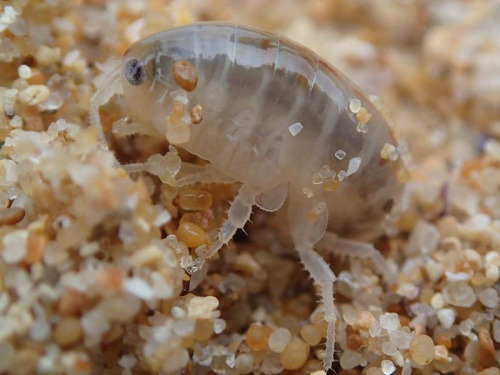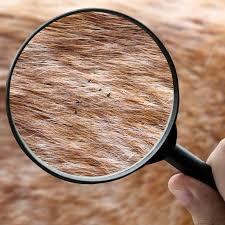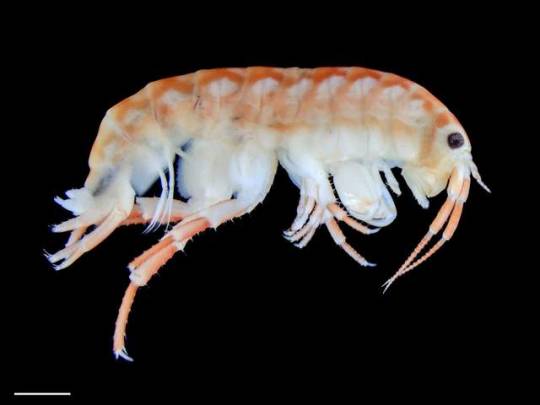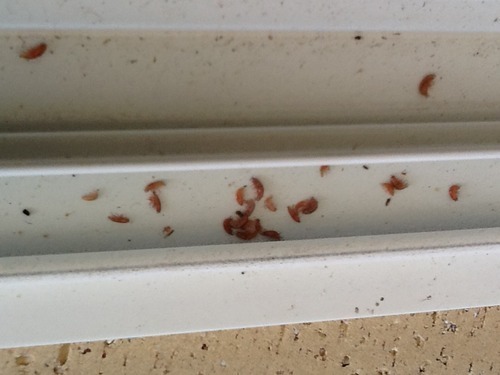#Talitridae
Text
Uncharismatic Fact of the Day
The next time you hit the beach, keep an eye out for sand hoppers! Only 1-2 cm (0.39-0.78 in) long, these tiny crustaceans can jump as high as 40 cm (15 in) or a distance of over a meter (39 in)! Their remarkable leaping abilities come from their tails, which sand hoppers tuck under their bodies and then flick out like a spring board.

(Image: A species of sand hopper, Talitrus saltator, by Eric Walravens)
If you like what I do, consider leaving a tip or buying me a ko-fi!
353 notes
·
View notes
Text

Faketober 2023 - Day 2 - Tiny
His name is Sandflee and he is a scaredy little guy. His antennae are incredibly sensitives to vibrations in the air. Whenever he detect something approching, I jump several dozens meters away and hide in the sand.
Loosely based on the Talitridae.
11 notes
·
View notes
Text
Sand Flea Rake

Sand Flea Rake
Sand fleas, also known as beach fleas or sand flies, are not fleas. m they are tiny crustaceans living in sandy areas like beaches. They can bite humans and animals, causing itchy and sometimes painful reactions, so it is always a good idea to take precautions when visiting sandy areas.
Do sand flea rake bite humans?
Both joint sand and chigoe flea bites tend to occur on your ankles and feet. They might appear in soft, fleshy areas between your toes, heels, or toenails. Sometimes, people also get bites and skin irritation on their thighs, hands, groin, or genitals.
What are sand flea rake, and how do you get them?
The colloquial name "sand flea" describes a creature that isn't an insect but a crustacean in the family Talitridae that lives in sandy areas under rocks and vegetation debris and causes no harm to humans or pets. In some areas, they are called beach fleas or sand hoppers instead of sand fleas.
What parasite is a bite of sand flea rake?
Sandfleas are biting insects that belong to the family Psychodidae. They can transmit certain diseases, but their bites are generally more annoying than serious health threats. It is best to avoid areas where sand fleas are known to be present and use protective measures like wearing long sleeves and using insect repellent to prevent their bites.
What diseases do sand fleas carry?
Sand fleas can cause itching, irritation, and sometimes small, red, itchy bumps on the skin due to their bites. While their edges are usually not harmful, some people may develop allergic reactions or experience more severe itching. It's always a good idea to avoid areas where sand fleas are present and take preventive measures to protect yourself from their bites.
How do you remove sand fleas?
The best approach is to focus on preventing their bites. Here are a few tips:
1. Avoid areas where sand fleas are known to be present, especially during peak activity times.
2. Wear long sleeves, pants, and shoes to reduce exposed skin.
3. Use insect repellent with DEET or other effective ingredients.
4. Shake out your clothing and beach gear after spending time in sandy areas.
5. shower and wash your clothes thoroughly after being in potential sand flea areas.
By taking these precautions, you can minimize the risk of getting bitten by sand fleas and avoid the hassle of removing them. Stay protected, and enjoy your time outdoors!
How long can sand flea rake live in your body?
The adult female sand flea burrows into the skin and grows 2000 times in size as eggs develop. The female flea typically lives for 4–6 weeks, when the eggs are expelled and fall to the ground.
How long do sand flea bites last on humans?
Common sand flea bites usually clear up in a few days. As for chigoe sand fleas, they eventually die and fall out of your skin, so the infestation usually resolves on its own. Most people don't experience it.
Do sand flea rake leave scars?
Pest Control for Sand Fleas
How to treat sand flea bites.
The large welts from sand flea bites may appear immediately or after a few days. Don't scratch – they can leave scars.
Can sand flea rake live in my bed?
Can fleas live in your bedding? Fleas can live in beds for about one to two weeks and burrow under sheets. Fleas need blood to survive, so they will only stay in one place for a short time if there is a food source.
Do sand fleas lay eggs in the skin?
Sand flea bites. Sometimes, but not always, the female sand flea lays her eggs underneath the skin; the large welts will have a black dot in the center. If that happens, you should seek medical attention because the black dot indicates eggs have been laid.
What do sand fleas eat?
sand flea rake: What are they? How to Avoid Them?
Seaweed
Although sand fleas primarily feed on organic debris such as seaweed and plankton, these critters occasionally bite humans. Female sand fleas are more susceptible to biting humans and use the protein from the blood as nutrition for laying eggs.
What does salt do to sand flea rake?
One way is by using salt, which kills off sand fleas. If you sprinkle salt on them, they often begin to lose water and eventually die. Allow the salt to stay for 24 hours before vacuuming, especially the carpet.
Conclusion
sand flea rake are biting insects that can cause itching and irritation with their bites. While they're usually more of an annoyance than a severe threat, avoiding their habitats and using protective measures is best to prevent their bites. Remember to wear long sleeves, use insect repellent, and shake out your clothing after being in the sandy areas.
Read the full article
0 notes
Photo

Mexorchestia carpenteri carpenteri
Wakulla County, Florida
These guys are seemingly the most common talitrid (sandhopper) in the panhandle area. I collected this guy by simply walking up to some beach debris disturbing it, and opening a vial, he jumped right in!
Surprisingly this species wasn’t formally described until 2014! It was previously known as “Tethorchestia sp. B.” a distinct species of Tethorchestia that probably is distinct enough for its own genus. Which was true and now the gulf coast has a proper name to put on this handsome species!
94 notes
·
View notes
Text
COMPARISON OF MOUTHPARTS OF TWO FAMILIES OF AMPHIPODS OF PULICAT LAKE, TALITRIDAE AND GAMMARIDAE | UTTAR PRADESH JOURNAL OF ZOOLOGY
Amphipods are tiny crustaceans with a wide range of behaviours and habitats in various ecosystems. These malacostracans are found in freshwater, brackish water, and a few terrestrial environments, and they play an important part in the lake's energetics. The mouthparts help amphipods serve as detrivores, an important trophic level in the aquatic ecology, as well as the adaptation of mouthparts to varied ecosystems. Amphipods from two families, Talitridae, an intertidal group, and Gammaridae, an aquatic group, had their mouthparts examined to see if they varied to fit their surroundings. The palps, size of the molars, and setae of the mouthparts were discovered to differ. The genera have undergone modest changes to adapt to the sort of food they consume. The absence of a mandibular palp in Talitridae and a highly setose maxilla in Gammaridae are notable differences. It has been discovered that it corresponds to their habits and food sources in their distinct habitats.
Please see the link :- http://mbimph.com/index.php/UPJOZ/article/view/2661
0 notes
Video
vimeo
Sand Hoppers - Light and Movement from Mark Broderick on Vimeo.
Talitridae is a family of amphipods. Terrestrial species are often referred to as land hoppers and beach dwellers are called sand hoppers or sand fleas.
They are an important food source for shore birds. Sand hoppers are sometimes referred to as Sand fleas. This refers only to their jumping abilities - don't confuse them with the bitey sand fly, Sand hoppers don't bite people and they love a good light show.
0 notes
Text
Sand-hoppers playing possum

The European sand-hopper (Talitrus saltator) playing possum
The European sand flea or sand-hopper, Talitrus saltator(Montagu, 1808) is an amphipod crustacean (Family Talitridae; Order Amphipoda) which lives on sandy shores from Norway to the Mediterranean. Most people have probably seen them hopping about on the beach, especially in the zone of wet sand created as waves go out or the tide…
View On WordPress
0 notes
Text
The importance of Arcitalitrus dorrieni (Hunt) (Crustacea: Amphipoda: Talitridae) in coniferous litter breakdo
http://dlvr.it/Pq6wKj
0 notes
Text
#627 - Talitrid Amphipods - Lawn Prawns

One of our local crustaceans. Not something I get many complaints about, because the only way they'll survive in a house is if there's a major moisture problem. Most amphipods can't survive out of water, but the Talitrid sandhoppers on the beach and landhoppers even further inland can be fully terrestrial.
Terrestrial amphipods are quite diverse in Australia, usually living in leaf litter. The ones you're most likely to find in your garden are translucent dark drown when alive, but turn pink-red after they die, like the ones in the photo above. Rarely above a centimeter in length.
5 notes
·
View notes
Text
I'm using two different books to identify an amphipod and they key out to the same genus but different families. This is really confusing.
4 notes
·
View notes
Photo

An adorable little talitrid amphipod (cf. Orchestia) hitching a ride on a Marsh Periwinkle (Littoraria irrorata).
St. Mark’s NWR, Wakulla County, Florida
90 notes
·
View notes
Photo

I find the life of a sand flea relatable
13 notes
·
View notes